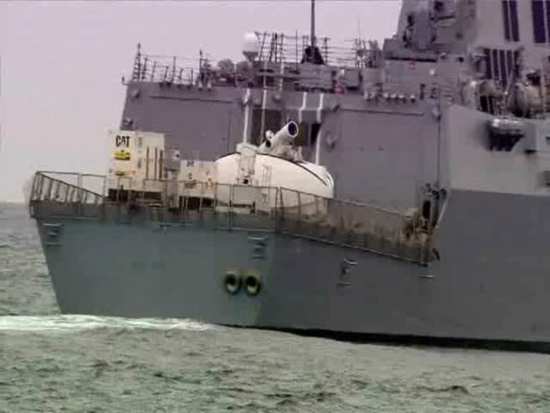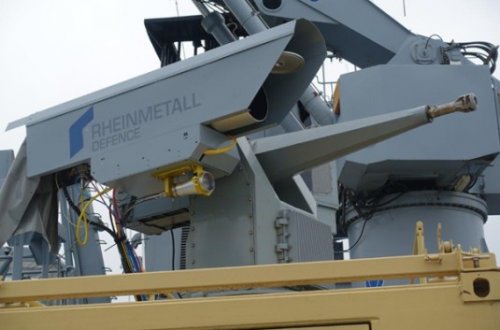MDA charts $1.3B course to new UAV-borne, missile-killing laser 'before 2020'
January 27, 2016
The Pentagon believes recent breakthroughs in directed-energy technology may augur well for a new speed-of-light missile defense program before the end of the decade, a potential game-changing capability that could arm unmanned aerial vehicles with compact lasers powerful enough to destroy enemy ballistic missiles early in flight.
On Jan. 19, Missile Defense Agency director Vice Adm. James Syring touted the Defense Department's new plan to resurrect the idea of a flying laser to knock down ballistic missiles during the boost-phase of flight -- the same objective of the Airborne Laser program, a $5 billion gambit begun in 1996 but terminated in 2009 due to affordability and technology concerns.
"We have significantly ramped up our program in terms of investment and talking about what else needs to be done to mature this capability," Syring said at a Jan. 19 address at the Center for Strategic and International Studies. He elaborated on steps the agency last year promised Congress "will prove the [directed-energy] technology is ready to execute missile defense missions before 2020."
Last February, MDA sent Congress a $50 million FY-16 research and development spending request for directed-energy projects, including $30.2 million to fund continued laboratory work on two different laser technologies and $19.8 million to fund the design of a UAV-borne, low-power laser demonstrator. While MDA budget documents forecast spending of more than $500 million on these two directed-energy projects between FY-16 and FY-20, Syring told Congress last year that when classified funding was factored in, the agency's planned spending on directed energy research was actually much larger.
"We are requesting over $1.3 billion -- both unclassified and classified -- funding which is a several-hundred-million-dollar increase over last year's budget," the three-star admiral told the House Armed Services strategic forces subcommittee on March 19 in response to being asked how much money was needed to advance directed energy research "at the most rapid pace possible." Syring added the $1.3 billion allocation "is right in terms of the balance of those resources," according to a subcommittee transcript of the hearing.
In the end, however, House and Senate appropriators granted MDA $26 million in FY-16 for continued research on the lasers -- a $4.2 million cut -- and denied all funding for the UAV-borne laser prototype request. Still, Syring during his CSIS address this month outlined MDA plans to continue working on directed energy in preparation for an FY-19 decision on whether the technology will be mature enough to proceed with a bona fide acquisition program for a UAV-borne, ballistic-missile-killing laser.
Lasers hold the potential to provide the U.S. military with a new way to track and destroy enemy ballistic missiles at much lower cost than the currently deployed fleet of land- and sea-based guided missile interceptors that strive to shoot down targets in either the mid- or terminal-phase of flight.
MDA's FY-16 budget documents indicate plans to collaborate with the Air Force, which is eyeing high-powered lasers for its next-generation fighter aircraft development project, as well as the Defense Advanced Research Projects Agency.
The CSIS event was sponsored by Boeing, which is pitching a UAV to carry a notional missile defense laser and was also prime contractor for the ABL program.
"It proved that this concept could work," Syring said on Jan. 19, referring to a brief video of a February 2010 ABL flight test that purported to show the heavily modified commercial 747 -- armed with a high-energy laser -- destroying a short-range ballistic missile target. "It proved that given enough power, given enough beam quality, given enough altitude, intercept of a ballistic missile . . . would be theoretically possible."
While the Navy three-star proceeded to underscore the complexity and challenges of fielding such a weapon during his remarks at the Washington think tank -- there are "many, many, many challenges here to get to boost-phase [intercept]," he said -- MDA in documents sent to Congress is clearly bullish on the potential for directed energy.
"The experience we gained from that successful first foray into directed-energy weapons [ABL] is pointing us along a new path that integrates a highly efficient, compact electric laser into a high-altitude, long-endurance unmanned aerial vehicle capable of flying in the stratosphere above the clouds which diffuse the laser energy," FY-16 budget documents MDA sent to Congress in February 2015 state. "Flying at low speed in the relatively calm air at 60,000 feet significantly reduces the complex beam pointing and atmospheric jitter compensation systems that were so troublesome on the ABL."
With lessons gleaned from the ABL program "and breakthrough research at our nation's premier scientific laboratories," MDA is "implementing an incremental roadmap that will prove the technology is ready to execute missile defense missions before 2020," the agency told Congress last year.
Since the ABL program was terminated, MDA has funded continued development of two high-energy laser technologies, the Diode Pumped Alkali Laser System (DPALS) with Lawrence Livermore National Laboratory in Livermore, CA; and Fiber Combining Lasers (FCS) with the Massachusetts Institute of Technology's Lincoln Laboratory. According to MDA, both of these technologies show "considerable promise."
To date, work on these efforts has yielded lasers that pack more power in smaller containers than ABL's directed-energy beam -- which provided 55 kilograms per kilowatt, according to Syring.
In the laboratory, Lawrence Livermore's DPALS has demonstrated a power density of 35 kilograms per kilowatt; and Lincoln Laboratories has demonstrated 40 kilograms per kilowatt, according to the admiral. Syring said these lasers must be much more efficient in order to destroy ballistic missiles while riding on a UAV.
"Where we need to be is at 5 kilograms per kilowatt or lower to have any chance of fielding it on a high-altitude platform that can be sustained for several days or several weeks," Syring told the CSIS audience. "How do you scale the fiber amplifiers down, how do you scale the technology down into a package that could be fielded?"
MDA is funding $26 million worth of research in FY-16 that aims to answer that very question.
"These key investments are targeted at driving the weigh per kW [kilowatt] of power in the fiber amplifier from a 5 kg [kilogram] per kW to 1kg per kW," according to the budget documents.
Specifically, MDA expects Lincoln Laboratories in FY-16 to complete critical design review and "begin fabrication and integration of the 5 kilograms per kW low size weight and power Fiber Combining Laser System," according to MDA's budget request. This work aims in part to build on a "successful" FCL 34-kilowatt demonstration, according to the budget request.
Lawrence Livermore, meanwhile, is to demonstrate a DPALS at 30 kilowatts average power, an upgrade from a 10-kilowatt system first light, according to MDA's budget request; the lab is also to begin design for a 120 kW DPALS "gain cell and pump delivery system."
In addition to the two laboratories, MDA noted in its FY-16 budget request that "Multiple industry partners continue to make steady progress in high power lasers."
"The MDA will select the best available high-energy laser technology from the national laboratories and/or industry for a follow-on prototype high-power laser demonstration in FY-19 with a [critical design review] in FY-20," the budget justification document states.
Citing "significant affordability and technology problems," then-Defense Secretary Robert Gates canceled a second planned Airborne Laser prototype aircraft on April 6, 2009, and transferred the lone ABL aircraft from MDA to the office of the director of defense research and engineering, to be used for research and development and renamed it the Airborne Laser Test Bed (ALTB).
The decision to wind down the program was also prompted by concerns about how to effectively employ the weapon system. The "operational concept of the Airborne Laser would have required that the aircraft orbit -- let's say the target was Iran -- would have required an orbit almost entirely within the borders of Iran," Gates told a House panel on May 13, 2009. "This is probably a little problematic."
The highly modified Boeing 747 now sits inactive in the Arizona desert, stripped of its critical high-energy components. -- Jason Sherman


